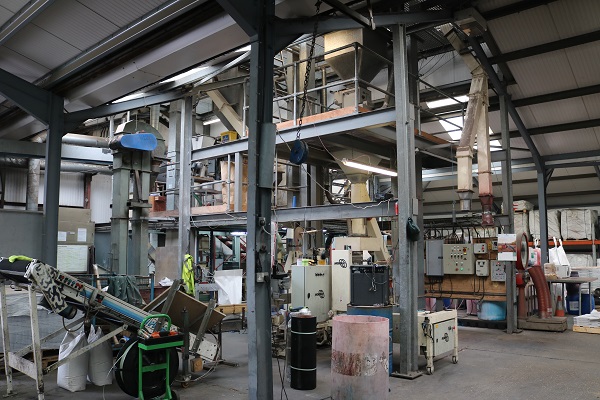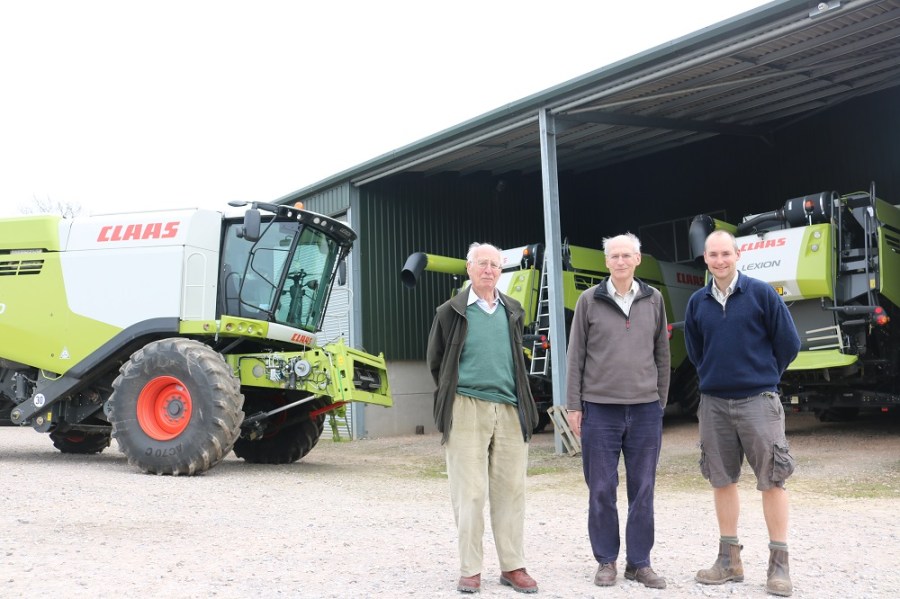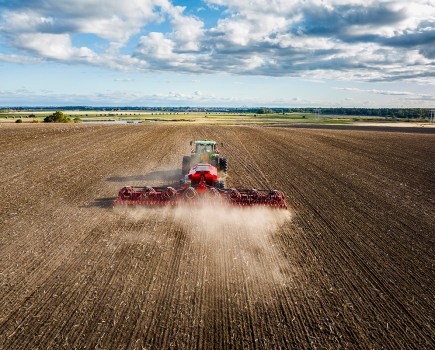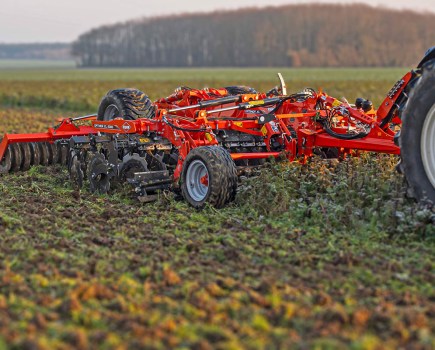There’s a wealth of technology on board the three Claas combines operated by a Hants seed-production business. CPM visits to find out how the three generations of farming experience is turning it into business benefits.
We need efficient combines that can reliably produce an excellent sample when the crop is ready to be harvested.
By Tom Allen-Stevens
As his father and grandfather look on, Tom Monk hops into the Claas Lexion 670, pulls it into position and starts to demonstrate some of its features.
“I’m very much the trainee on the team,” he says modestly, in deference to the other family members in the business. But both his father, Richard, and grandfather Anthony freely admit that Tom knows most about the advanced features shared across the three new Lexion machines, acquired over the past three years, and will probably be the one responsible for turning these into business benefits.

The Monks have their own seed-processing plant, specialise in high-grade seed and have some pre-basic contracts.
AF Monk (Rookley) operates across 1250ha of arable cropping, based near Stockbridge, Hants. It was Anthony who founded the business almost 60 years ago, and although now retired, he still plays an active part in its day-to-day affairs. This started with 344ha of dairy, arable and later beef, but the arable side soon specialised into growing seed crops, and as the business expanded and more land was taken on, the cattle enterprise was dropped.
“Our main customer used to be John Bryant Seeds, based at Romsey, but we now grow for a number of merchants,” explains Richard. “We have our own seed-processing plant and prefer to supply both local and national companies that may not have their own facilities. We have some pre-basic contracts and specialise in high-grade seed.”
Some of this is herbage seed, with both winter and spring crops of oats, barley, oilseed rape and wheat. Peas, linseed, soya and poppies are also grown and processed on the farm. 45% of the area is planted to spring-sown crops, with a harvest that stretches from mid July until the end of Sept. “We have over 30 varieties to harvest and spend a lot of time cleaning down the harvester between crops. We need efficient combines that can reliably produce an excellent sample when the crop is ready to be harvested,” says Richard.
Anthony recalls the two Ransomes 902 combines that brought in the business’ first harvest in 1960, each having an output of up to 6t/hr. For the past 20 years, though, Claas technology has been relied on to bring in the crop, and today’s machines can eat through a wheat crop at over 80t/hr. The two Lexion 670 combines with 7.5m headers were purchased in 2017 and 2018, and an ex-demo Lexion 760 with a 9m header now joins them in the shed.
The new machine is based on Claas’ APS Hybrid rotary threshing technology, while the two 670 models have straw walkers. All are Montana models, equipped to deal with the steep slopes of the Hants Downs, and have Claas Telematics plus a range of automated features on board, aimed at optimising performance.
“The straw is valuable for a lot of the crops we harvest, and that’s particularly the case with the hay by-product from the grass, which is where the two straw-walker machines are best suited,” explains Richard. “The 760 hybrid is the maximum throughput machine, and means we can progress well through other crops where straw is less of a consideration. Growing seed crops means we can’t desiccate, so a machine that achieves a good sample in a variety of field conditions is a priority.”
It’s also important to be able to interchange headers between machines – a Capello Spartan disc-mower header has recently been purchased to improve performance of the herbage enterprise. “Grass is often the trickiest crop to manage, although linseed can also be difficult. We’re getting good results on the herbage side with the disc-mower, that’s better suited to the crop than a reciprocating knife.”
The combines aren’t the first Montana models the business has had. “We have enough steep slopes to need to minimise the resulting losses,” continues Richard. “Montana does a good job of keeping the screens level. At the end of a variety, we move it side to side to help clean out the combine, followed by the airline and hoover. Also, when unloading light herbage seed you can lean the combine towards the grain trailer which keeps the auger out of the wind.”
All three models have Vario headers, which has cut downtime, he adds. “Changing from cereals to oilseed rape in particular used to be a two-man job, but now it’s quite a simple, quick change. The header allows easy adjustments to suit different crops, which is important when you’re switching between crops as much as we are.”
But the automated features and data management aspects of the new machines have yet to prove their worth, reveals Tom. “Laser Pilot that guides the steering to follow the edge of the crop works well and means you can focus on other settings. The CEMOS system is easy to use and allows you to enter presets that should maintain grain quality and adjust it for you. The difficulty with CEMOS Automatic is that the standard settings allow a level of wastage greater than we’re prepared to accept.”
The move into precision farming started with autosteer, and for the past two or three years, the farm has increasingly moved to applying inputs at a variable rate, using the IPF platform, which has now been rebranded as Rhiza. “Five out of our seven tractors are now on GPS, and it’s John Deere’s Greenstar system we’ve been using. It’s when you move away from the one brand that the difficulties start to accumulate,” says Tom.
The farm is moving over to variable rate seeding and just getting the JD tractor to talk to the 740A drill has been a struggle, he says. “We’re trying to make everything more precise and do everything that the technology is supposed to allow, including section control and auto shut-off. But some features don’t work properly and we’re promised updates that never come.”
On the harvesting side, it’s the yield-mapping Tom finds most valuable, but making it work correctly has required more of his time than he feels it should. “We’ve had Telematics for three years – with three different operators and three machines it makes sense to have a system that pulls all the data together, and real-time information on locations and progress is fed through to a smartphone app.
“But in practice it works better for operators just to stay in touch with each other, and I’m not convinced Telematics is actually doing much to co-ordinate the harvest operation better. It’s also not as seamless as it should be and has been very frustrating and time-consuming to set up.”
Tom feels he’s spent a lot of time on a computer setting up the system, and calibrating machines to ensure that it’s working correctly. Even then, it hasn’t been without its mishaps – they lost a whole field of yield data last year because the system wasn’t activated. “We’ve had good back-up from Olivers, our local dealer, who have sorted out any problems. But that doesn’t replace the lost data and downtime that shouldn’t have happened in the first place.”
Moving to precision farming and digitalisation is a challenge farmers face, and one that Claas strives hard to help with, notes Edward Miller, of Claas EASY (Efficient Agriculture Systems). “Customer expectation of this transition is managed carefully, with a year’s free-of-charge support for yield mapping provided through SOYL, together with training sessions offered through the local dealer,” he says.
For Tom, integrating with Gatekeeper, to bring the yield information into crop records and export data back to the machine, has also been frustrating. “It’s possible, but it’s not easy. We’ve also had difficulties with the software interpreting the data wrong from our machines using different headers – all these things take time to sort out.”
An application programme interface (API) is under development, notes Edward. “This should allow a similar level of integration with Gatekeeper that you get with the Claas Telematics cloud-based system.”
Tom admits their arable enterprise is a relatively complex one, with very high standards to maintain – just ensuring the yield monitor is properly calibrated across all 33 varieties they grow is a chore in itself. But it makes the £2290 fee per machine for the three-year licence for the full functionality feel expensive.
“It’s easy to get a print-out of a yield map for one of our landowners, for example. Also I can see that once we have several years of data, it will be a valuable resource in making well informed decisions, such as taking out unproductive field corners. But I’m not convinced we’re there yet with a system that delivers true value to a farming business.”
Edward notes that 95% of Claas customers now with yield mapping use Telematics very successfully. “We work with users to address initial doubts about the competence of the system. We’re finding these are alleviated as we build a greater understanding of what knowledge we need to provide, and how we communicate it.”
The features to maintain a level, even flow
Montana is Claas’ system designed to maintain threshing performance on steep slopes. Hydraulic swing rams turn the portals of the drive axle to adjust the wheels to the ground. The Montana chassis compensates cross tilt by up to 17% and longitudinal tilt of up to 6% so the combine can operate effectively on steep terrain and deliver the threshing output you’d expect on level ground. It also keeps the operator on the level and allows a forward speed through the hydrostatic drive up to 30km/h.
For the cutterbar (up to 9m), the Multi Contour system moves the pivoting frame, adjusts the cutting angle and performs all the Auto Contour functions. The Montana feeder housing has a horizontal ram for cutting angle adjustment as well as two vertical rams for Auto Contour control and side slope levelling.
Cruise Pilot automatically controls the harvesting speed for optimal results on the basis of the engine load. Depending on the travel mode, the system uses various machine parameters simultaneously for control: ground speed, crop volume in the feeder housing and grain losses. You can set it to adjust to allow a constant throughput, constant throughput and losses or to a maximum loss rate.
Auto Crop Flow monitors the speed of various machine components to provide early warning of critical peak loads. This includes the APS threshing unit – a pre-accelerator designed to even out the flow and improve threshing performance – and the Roto Plus rotors in the residual grain separation system. In the straw management area, the system detects if the straw chopper and power spreader are stationary. Controlled in CEBIS, there are three levels of slip-limit sensitivity so you can set it to match the conditions in the field.
Ways to monitor, manage and measure harvest progress
Claas Telematics is designed to give you access to all the important data for your combine anytime, anywhere via the internet. The Fleet View app informs all the operators in a harvesting team about the positions of all the machines in the fleet and the current grain tank fill levels of harvesters. This allows those on the grain carts to empty the harvesters when required without downtime.
An operating time analysis report is sent to you by email each day so you can review the specific data from the previous day. Relevant data, such as area-specific yields, can then be exported to your field records. All the info is stored on the Telematics web server so you can compare the performance and harvesting data for your machines, informing how you might like to fine-tune settings to suit conditions on the day. Optional automatic documentation hives all this data away as it’s generated by the machine without the operator having to lift a finger.
CEBIS is the on-board brain behind Claas’ technical gadgetry, accessed by the user through CEBIS Mobile in real time. Agrocom Map Start software also allows you to prepare customer and parcel data to be run and processed. All data is backed up when a specific task is completed or the working day comes to an end. This, as well as daily counts, crop counts and total counts, can be printed out on the combine, transferred via a data card or uploaded to the Telematics server.
But it’s the yield-mapping functionality most growers are after. On-board sensors in the Lexion measure grain moisture and yield, allowing the Quantimeter to determine the precise quantity harvested. CEBIS adds geographic coordinates using GPS satellite data. Again, this data can be transferred via a data card or uploaded to the Telematics server, as well as fed through to the operator in real time via the in-cab terminal.
The S10 is a 10.4” (26cm) touchscreen terminal that can be used for ISOBUS functions. These include ISOBUS-based task management (ISO TC-BAS) that gathers data such as the area worked, yield, grain moisture and working time to generate yield maps and transmit live images to the cab. ISO-TC-GEO corrects for bout width and adjusts data automatically saving the operator having to make manual changes.
CEMOS is the Claas umbrella term for all the systems designed to optimise machine performance. There’s CEMOS Dialog that guides the operator through a number of steps in order to achieve the optimum machine configuration. Then there’s CEMOS Automatic in which the machine does it for you. This encompasses Auto Cleaning, Auto Separation and Auto Threshing.
All CEMOS Automatic functions adjust the machine continuously and automatically in line with the current harvesting conditions. The aim is to provide maximum throughput with top grain quality and clean grain while keeping fuel consumption to a minimum, says Claas. They’re available for wheat, barley, triticale, rye, rapeseed and maize while just Auto Cleaning and Separation are available for oats and soybeans.
The Grain Quality Camera is perhaps the most important sensor for automatic adjustment of the threshing unit and cleaning system. It not only feeds through real-time pictures of the crop from the elevator but scans these for levels of non-grain constituents (NGC) and broken grains. The information and live images are relayed to the operator, allowing adjustments to be made, or it can guide CEMOS Automatic.
When the combine starts work in the field, CEMOS Automatic configures the machine to certain preset values, then establishes the optimal setting. This takes account and adjusts to changing harvesting conditions throughout the day. The claim from Claas is that the machine fine tunes adjustments on a scale that not even a skilled operator could match.
Finally, there’s also Remote Service, which allows your dealer to access your machine and its specific data directly for maintenance and servicing purposes. Claas covers the cost of this for five years, if you give your consent to engineers having remote access to your machine’s system and data.
Farm facts
AF Monk (Rookley), Stockbridge, Hants
- Farmed area: 1250ha
- Soil: Mostly chalk over flint with a few clay caps
- Cropping: Winter and spring oats, barley, oilseed rape and wheat; herbage seed, peas, linseed, soya and poppies
- Staff: Five plus three on seed plant
- Mainline tractors: Case Puma 240, 220; Massey Ferguson 7620; 2x John Deere 6155R, JD 6930; New Holland T6080
- Combines: 2x 7.5m Claas Lexion 670, 9m Lexion 760 all with Vario headers; 5m Capello Spartan disc-mower header
- Sprayer: 32m Sands Horizon 4000-litre self-propelled; 6000-litre mixer wagon
- Spreader: Amazone ZA-TS with 4200-litre hopper
- Primary cultivation equipment: 7f Kuhn Vari-Leader, 6f Kverneland, 5f Kverneland, 6.5m Väderstad Carrier, 8m Vaderstad NZ, 8m Kongskilde Vibromaster, 2x 12m Twose rolls
- Drill: 8m John Deere 740A
- Loaders: JCB TM310S, TM320S, 541-70
- Balers – 2x Welger AP830




